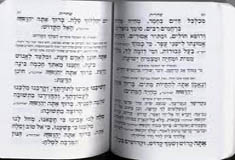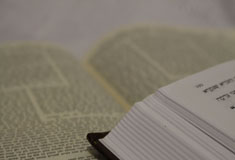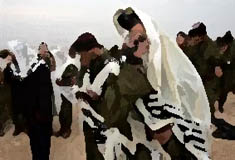Tefillah on the Move: Navigating Prayer While Traveling
הרב שי טחןיח אב, תשפה12/08/2025s many take advantage of the weeks after Tisha B’Av and before the start of the school year to travel, a frequent challenge presents itself — how to daven properly while on vacation?
תגיות:תפילהחופשהנופש
As many take advantage of the weeks after Tisha B’Av and before the start of the school year to travel, a frequent challenge presents itself — how to daven properly while on vacation. Outside the structured environment of one’s local shul, travelers must contend with noise, distractions, and a lack of privacy. The following offers practical guidance for these situations, outlining how to choose a setting that preserves the sanctity and concentration of tefillah, even far from home.
even far from home.
a. It is an obligation to dress appropriately for prayer, even when on vacation, and one should be careful to dress properly even if praying alone in his room.
Many feel more casual when away from their city on vacation and therefore approach prayer in an inappropriate manner — for example, praying in flip-flops, shorts, or a tank top; some even pray without a shirt at all, or with only a tallit katan over their body. All of this is prohibited, even if no one else can see him. The Gemara (Shabbat 10a) teaches that one must dress respectfully for prayer, deriving this from the pasuk: “Prepare to meet your G-d, O Israel.”
The Shulchan Aruch (siman 98:4) writes: “Prayer takes the place of the Korbanot; therefore, one must take care that it should be like the offering… It is proper to have fine garments designated for prayer, like the priestly garments, though not everyone can afford this. Nevertheless, it is good to have special pants for prayer for the sake of cleanliness.”
Rabbi Auerbach writes: “At the time of prayer, one must take care to appear in a respectable manner, as one standing before the King. Therefore, even one who customarily works in shorts, such as farmers or laborers, should preferably not pray dressed that way.” Rabbi Ovadia Hadaya likewise warns (in Yaskil Avdi) not to pray in short-sleeved shirts, and certainly not to serve as a shaliach tzibbur in such attire. Just as one would not dare to enter a courtroom, a beit din, or the office of the president in such clothing, all the more so should one not stand that way before the King of kings.
This is in contrast to the ruling of Rabbi Ovadia Yosef who permits praying in short sleeves and shorts, provided one does not serve as shaliach tzibbur in such clothing. If the sleeves cover the arm up to the elbow, he even permits serving as shaliach tzibbur while wearing them.
b. If one needs to pray while on the road, he should look for a quiet place where he will not be disturbed during his prayer. It is preferable, if possible, to pray in a place surrounded by walls; if such a place is not found, one should try to pray among trees.
Shulchan Aruch (90:5) rules that one should not pray in an open area, such as a field. The Mishnah Berurah notes that it is permitted if one stands at the side of the road in a location where there is no concern that passersby will disturb him. The Magen Avraham adds that this restriction does not apply to travelers, who are permitted from the outset to pray in a field.
Nevertheless, if there are trees present, it is better to stand among them and pray, as we find that Yitzchak went out “to converse in the field” — and “to converse” means that he concealed himself for prayer among the bushes (Bach).
Similarly, it is preferable to pray in a place surrounded by partitions, even if it is not roofed.
c. If one is in a place without a synagogue, he should try to gather a minyan of ten men in his room for prayer.
The Gemara (Berachot 7b) relates: “Rabbi Yitzchak said to Rav Nachman: Why does the master not come to the shul to pray? He answered: I am unable. He asked further: Then let the master gather ten and pray [at home]. He replied: It is burdensome for me.” From here we see that one who cannot get to a shul should gather ten men to pray in his room as long as its not very hard to gather.
d. One who is praying on an airplane or ship and does not know where east is should try to determine it using a compass or a phone application. If he is on a flight leaving Israel, he may pray facing the tail of the plane; if he is on a flight to Israel, he should face the front of the plane. In any case, he should direct his heart to his Father in Heaven.
The Shulchan Aruch (94:1) writes: “When one rises to pray, if he is standing outside the Land [of Israel], he should turn his face toward Eretz Yisrael and also direct his thoughts toward Yerushalyim.
However, sometimes one is in a place where it is difficult to determine directions, such as on a plane or ship; in such a case, he should simply direct his heart to his Father in Heaven, as the Shulchan Aruch (94:3).
There is, however a practical tip to know where east is by the direction of the plane’s travel, since planes generally fly in a straight line. One may orient himself accordingly, even though the plane may occasionally veer to the sides, because overall the flight maintains a consistent direction. For example, if flying to Israel, he should face the front of the plane; if flying from Israel abroad, he should face the rear of the plane (Or LeTzion).
At times, however, facing this direction for prayer might place him in a position that distracts his concentration or exposes him to improper sights. In such cases, it is preferable to pray facing another direction, even if that is not east, since the essence of prayer is the service of the heart (Zichron Yehuda).
e. Those who designate a place for prayer in a hotel should set up a partition between the men and the women, and should not pray there without a partition. Nevertheless, those who arrange a minyan in an airport or on a flight, in a location that does not disturb other passengers, are not required to set up a partition between the men and the women.
That is the opinion of Rav Moshe Feinstein, and Rav Auerbach since the obligation of a partition applies only in a place designated for regular prayer, whereas in an airport area, the prayer is conducted only on a temporary basis, and also it’s a place where one can’t ask women to go elsewhere.
f. If one is on a flight with non-Jews during the time for Keriat Shema and Tefillah and feels uncomfortable praying with tefillin, he should pray without them and put them on after disembarking from the plane.
Although the Shulchan Aruch (25:4) rules that one should have tefillin on during Keriat Shema and Tefillah so as not to appear as if bearing false witness against himself, the Mishnah Berurah (25:14) writes that this requirement applies only when one intentionally neglects to put on tefillin before Keriat Shema out of laziness. However, when traveling and unable to put them on due to other circumstances, there is certainly no need to delay Keriat Shema because of this. From the fact that it specifies “only when done out of laziness,” we learn that if one feels very uncomfortable putting on tefillin on the plane, it is better to recite Shema and pray without them, and put them on after disembarking. All the more so should this be done if there is any concern of danger in putting them on in a place where there might be anti-Semites.
g. One should not hold a minyan in the airplane aisles if it disturbs passengers, nor should an individual pray in the aisle.
Rav Elyashiv (quoted in Vayishma Moshe, p. 31) said that since all passengers have rights to use the aisles, one should not conduct a minyan there — even if there is only one person who is inconvenienced and objects.
Similarly, Rav Shmuel Vosner wrote that one should strive to pray the rest of the prayers seated in his place, and only recite the Amidah near his seat in a way that does not block passersby. If it is not possible to pray while standing in place, it is preferable to remain seated during the prayer, which also benefits concentration and modesty.
Rav Auerbach likewise wrote that one praying during a flight should recite the Amidah seated in his seat and not in the aisles, since it disturbs others passing through. Rav Moshe Feinstein also permitted praying while seated if standing is difficult or if standing would cause distraction.
In BeLechtecha VaDerech (p. 34), it is recorded that the rabbi of El Al Airlines, Rabbi Yochanan Hayut, asked Rav Vosner about a man who wished to donate a small Sefer Torah and an ark to be used during flights for Torah reading. Rav Vosner responded that this should not be done at all, as one should not conduct a minyan or arrange public prayers during a flight.
In Yalkut Yosef it is reported that Rav Ovadia Yosef himself refused to join a minyan that was being organized on a plane.

a. It is an obligation to dress appropriately for prayer, even when on vacation, and one should be careful to dress properly even if praying alone in his room.
Many feel more casual when away from their city on vacation and therefore approach prayer in an inappropriate manner — for example, praying in flip-flops, shorts, or a tank top; some even pray without a shirt at all, or with only a tallit katan over their body. All of this is prohibited, even if no one else can see him. The Gemara (Shabbat 10a) teaches that one must dress respectfully for prayer, deriving this from the pasuk: “Prepare to meet your G-d, O Israel.”
The Shulchan Aruch (siman 98:4) writes: “Prayer takes the place of the Korbanot; therefore, one must take care that it should be like the offering… It is proper to have fine garments designated for prayer, like the priestly garments, though not everyone can afford this. Nevertheless, it is good to have special pants for prayer for the sake of cleanliness.”
Rabbi Auerbach writes: “At the time of prayer, one must take care to appear in a respectable manner, as one standing before the King. Therefore, even one who customarily works in shorts, such as farmers or laborers, should preferably not pray dressed that way.” Rabbi Ovadia Hadaya likewise warns (in Yaskil Avdi) not to pray in short-sleeved shirts, and certainly not to serve as a shaliach tzibbur in such attire. Just as one would not dare to enter a courtroom, a beit din, or the office of the president in such clothing, all the more so should one not stand that way before the King of kings.
This is in contrast to the ruling of Rabbi Ovadia Yosef who permits praying in short sleeves and shorts, provided one does not serve as shaliach tzibbur in such clothing. If the sleeves cover the arm up to the elbow, he even permits serving as shaliach tzibbur while wearing them.
b. If one needs to pray while on the road, he should look for a quiet place where he will not be disturbed during his prayer. It is preferable, if possible, to pray in a place surrounded by walls; if such a place is not found, one should try to pray among trees.
Shulchan Aruch (90:5) rules that one should not pray in an open area, such as a field. The Mishnah Berurah notes that it is permitted if one stands at the side of the road in a location where there is no concern that passersby will disturb him. The Magen Avraham adds that this restriction does not apply to travelers, who are permitted from the outset to pray in a field.
Nevertheless, if there are trees present, it is better to stand among them and pray, as we find that Yitzchak went out “to converse in the field” — and “to converse” means that he concealed himself for prayer among the bushes (Bach).
Similarly, it is preferable to pray in a place surrounded by partitions, even if it is not roofed.
c. If one is in a place without a synagogue, he should try to gather a minyan of ten men in his room for prayer.
The Gemara (Berachot 7b) relates: “Rabbi Yitzchak said to Rav Nachman: Why does the master not come to the shul to pray? He answered: I am unable. He asked further: Then let the master gather ten and pray [at home]. He replied: It is burdensome for me.” From here we see that one who cannot get to a shul should gather ten men to pray in his room as long as its not very hard to gather.
d. One who is praying on an airplane or ship and does not know where east is should try to determine it using a compass or a phone application. If he is on a flight leaving Israel, he may pray facing the tail of the plane; if he is on a flight to Israel, he should face the front of the plane. In any case, he should direct his heart to his Father in Heaven.
The Shulchan Aruch (94:1) writes: “When one rises to pray, if he is standing outside the Land [of Israel], he should turn his face toward Eretz Yisrael and also direct his thoughts toward Yerushalyim.
However, sometimes one is in a place where it is difficult to determine directions, such as on a plane or ship; in such a case, he should simply direct his heart to his Father in Heaven, as the Shulchan Aruch (94:3).
There is, however a practical tip to know where east is by the direction of the plane’s travel, since planes generally fly in a straight line. One may orient himself accordingly, even though the plane may occasionally veer to the sides, because overall the flight maintains a consistent direction. For example, if flying to Israel, he should face the front of the plane; if flying from Israel abroad, he should face the rear of the plane (Or LeTzion).
At times, however, facing this direction for prayer might place him in a position that distracts his concentration or exposes him to improper sights. In such cases, it is preferable to pray facing another direction, even if that is not east, since the essence of prayer is the service of the heart (Zichron Yehuda).
e. Those who designate a place for prayer in a hotel should set up a partition between the men and the women, and should not pray there without a partition. Nevertheless, those who arrange a minyan in an airport or on a flight, in a location that does not disturb other passengers, are not required to set up a partition between the men and the women.
That is the opinion of Rav Moshe Feinstein, and Rav Auerbach since the obligation of a partition applies only in a place designated for regular prayer, whereas in an airport area, the prayer is conducted only on a temporary basis, and also it’s a place where one can’t ask women to go elsewhere.
f. If one is on a flight with non-Jews during the time for Keriat Shema and Tefillah and feels uncomfortable praying with tefillin, he should pray without them and put them on after disembarking from the plane.
Although the Shulchan Aruch (25:4) rules that one should have tefillin on during Keriat Shema and Tefillah so as not to appear as if bearing false witness against himself, the Mishnah Berurah (25:14) writes that this requirement applies only when one intentionally neglects to put on tefillin before Keriat Shema out of laziness. However, when traveling and unable to put them on due to other circumstances, there is certainly no need to delay Keriat Shema because of this. From the fact that it specifies “only when done out of laziness,” we learn that if one feels very uncomfortable putting on tefillin on the plane, it is better to recite Shema and pray without them, and put them on after disembarking. All the more so should this be done if there is any concern of danger in putting them on in a place where there might be anti-Semites.
g. One should not hold a minyan in the airplane aisles if it disturbs passengers, nor should an individual pray in the aisle.
Rav Elyashiv (quoted in Vayishma Moshe, p. 31) said that since all passengers have rights to use the aisles, one should not conduct a minyan there — even if there is only one person who is inconvenienced and objects.
Similarly, Rav Shmuel Vosner wrote that one should strive to pray the rest of the prayers seated in his place, and only recite the Amidah near his seat in a way that does not block passersby. If it is not possible to pray while standing in place, it is preferable to remain seated during the prayer, which also benefits concentration and modesty.
Rav Auerbach likewise wrote that one praying during a flight should recite the Amidah seated in his seat and not in the aisles, since it disturbs others passing through. Rav Moshe Feinstein also permitted praying while seated if standing is difficult or if standing would cause distraction.
In BeLechtecha VaDerech (p. 34), it is recorded that the rabbi of El Al Airlines, Rabbi Yochanan Hayut, asked Rav Vosner about a man who wished to donate a small Sefer Torah and an ark to be used during flights for Torah reading. Rav Vosner responded that this should not be done at all, as one should not conduct a minyan or arrange public prayers during a flight.
In Yalkut Yosef it is reported that Rav Ovadia Yosef himself refused to join a minyan that was being organized on a plane.
הוסף תגובה
עוד מהרב שי טחן
עוד בנושא הלכה






